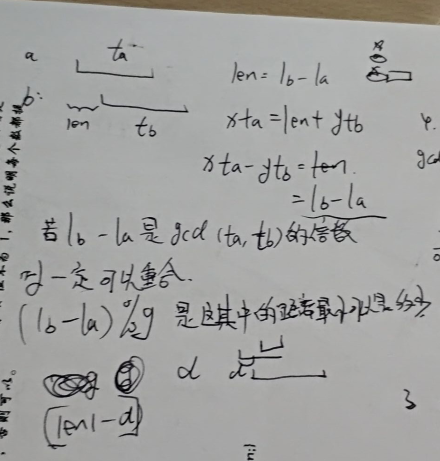Bob and Alice are often participating in various programming competitions. Like many competitive programmers, Alice and Bob have good and bad days. They noticed, that their lucky and unlucky days are repeating with some period. For example, for Alice days [la;ra] are lucky, then there are some unlucky days: [ra+1;la+ta−1], and then there are lucky days again: [la+ta;ra+ta] and so on. In other words, the day is lucky for Alice if it lies in the segment [la+kta;ra+kta] for some non-negative integer k
.
The Bob's lucky day have similar structure, however the parameters of his sequence are different: lb
, rb, tb. So a day is a lucky for Bob if it lies in a segment [lb+ktb;rb+ktb], for some non-negative integer k
.
Alice and Bob want to participate in team competitions together and so they want to find out what is the largest possible number of consecutive days, which are lucky for both Alice and Bob.
The first line contains three integers la
, ra, ta (0≤la≤ra≤ta−1,2≤ta≤109
) and describes Alice's lucky days.
The second line contains three integers lb
, rb, tb (0≤lb≤rb≤tb−1,2≤tb≤109
) and describes Bob's lucky days.
It is guaranteed that both Alice and Bob have some unlucky days.
Print one integer: the maximum number of days in the row that are lucky for both Alice and Bob.
0 2 5
1 3 5
2
0 1 3
2 3 6
1
The graphs below correspond to the two sample tests and show the lucky and unlucky days of Alice and Bob as well as the possible solutions for these tests.


题意 : 两个人轮流会有幸运天,给你两个人的幸运天的分布情况,是按周期的,问最终重复的幸运天最多是多少?
思路分析 :

代码示例 :
#define ll long long
ll l1, r1, t1;
ll l2, r2, t2;
ll gcd(ll a, ll b){
return b==0?a:gcd(b, a%b);
}
void solve() {
if (l1 > l2) {swap(l1, l2); swap(r1, r2); swap(t1, t2);}
ll len1 = r1-l1+1, len2 = r2-l2+1;
ll g = gcd(t1, t2);
ll ans = 0;
ll d = (l2-l1)%g;
ans = max(ans, min(len1-d, len2));
ll yd = g-d;
ans = max(ans, min(len1, len2-yd));
printf("%lld
", ans);
}
int main() {
//freopen("in.txt", "r", stdin);
//freopen("out.txt", "w", stdout);
cin >> l1 >> r1 >> t1;
cin >> l2 >> r2 >> t2;
solve();
return 0;
}